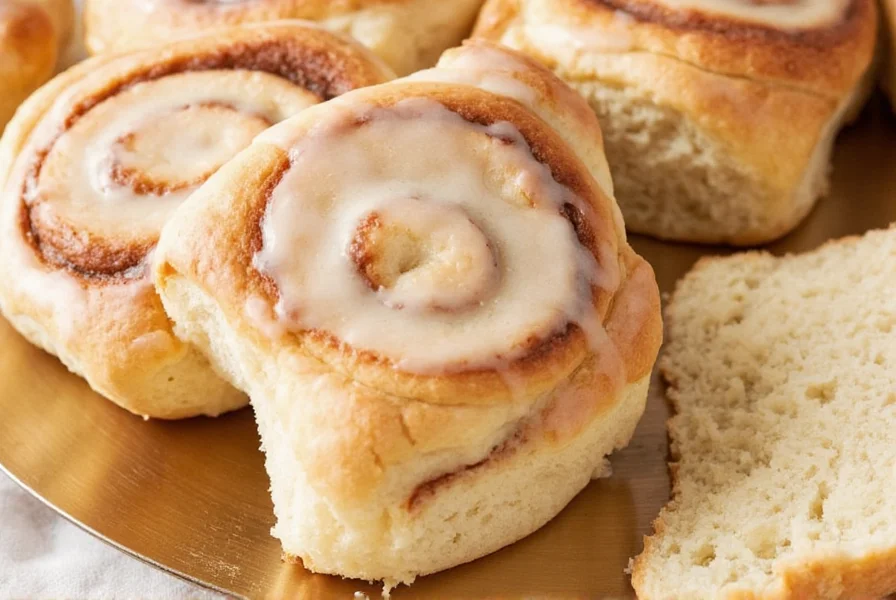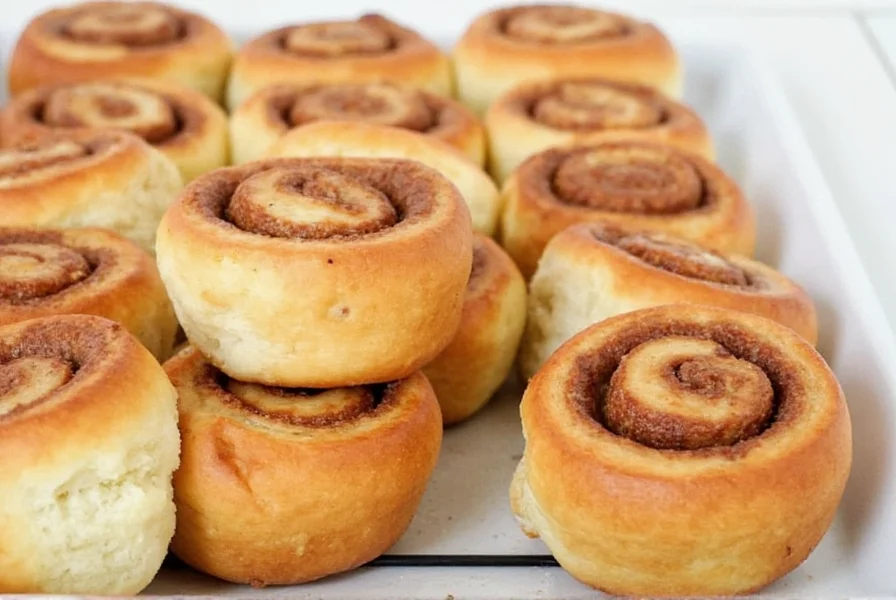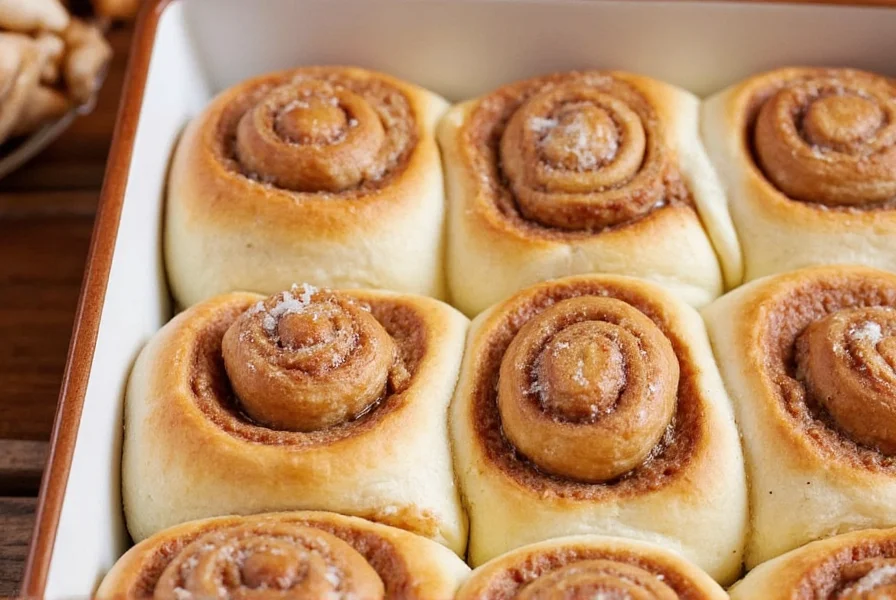The best cinnamon roll recipe features a soft, fluffy yeast dough rolled with a perfect cinnamon-sugar-butter filling and topped with a smooth cream cheese icing. This tested recipe yields bakery-quality cinnamon rolls with clear instructions for success every time, including proper dough temperature, rolling technique, and baking times for optimal results.
Nothing compares to the aroma of freshly baked cinnamon rolls filling your kitchen. These homemade cinnamon rolls deliver that perfect balance of tender dough, spiced filling, and creamy icing that makes them a breakfast favorite. Unlike store-bought versions, this best cinnamon roll recipe from scratch gives you complete control over ingredients and texture.
After testing dozens of variations over 15 years of baking experience, I've perfected this homemade cinnamon rolls with yeast formula that consistently produces soft, pillowy rolls with just the right amount of cinnamon swirl. The secret lies in proper dough temperature control and the filling-to-dough ratio.
Classic Cinnamon Roll Recipe
| Prep Time | Cook Time | Total Time | Servings |
|---|---|---|---|
| 2 hours | 25 minutes | 3 hours | 12 rolls |
Ingredients
Dough
- 1 cup whole milk, warmed to 110°F (43°C)
- 2 ¼ teaspoons active dry yeast (1 packet)
- ⅓ cup granulated sugar
- ½ cup unsalted butter, melted and cooled slightly
- 2 large eggs, room temperature
- 4 cups all-purpose flour, plus more as needed
- 1 teaspoon salt
Filling
- ½ cup unsalted butter, softened to room temperature
- 1 cup packed light brown sugar
- 3 tablespoons ground cinnamon
- ¼ teaspoon salt
Cream Cheese Icing
- 4 ounces cream cheese, softened
- ¼ cup unsalted butter, softened
- 1 cup powdered sugar
- 1 teaspoon vanilla extract
- 2-3 tablespoons milk
- Pinch of salt
Step-by-Step Instructions for Perfect Cinnamon Rolls
Preparing the Dough
Start by warming your milk to exactly 110°F (43°C)—too hot will kill the yeast, too cold won't activate it properly. This temperature control is crucial for easy cinnamon roll recipe for beginners to succeed. Combine the warm milk, yeast, and 1 tablespoon of the sugar in a small bowl. Let sit for 5-10 minutes until foamy.
In the bowl of a stand mixer fitted with a dough hook, combine the yeast mixture, remaining sugar, melted butter, eggs, 2 cups of flour, and salt. Mix on low speed until combined. Gradually add the remaining flour, ½ cup at a time, until a soft dough forms that pulls away from the sides of the bowl.
Knead the dough for 5-7 minutes until smooth and elastic. If the dough sticks to your fingers, add flour 1 tablespoon at a time. The ideal cinnamon roll dough recipe should be slightly tacky but not sticky.

First Rise
Place the dough in a lightly greased bowl, turning to coat all sides. Cover with plastic wrap and a clean kitchen towel. Let rise in a warm, draft-free place for 1-1.5 hours, or until doubled in size. The ideal temperature for rising is 75-80°F (24-27°C).
Rolling and Filling
Punch down the risen dough and turn it out onto a lightly floured surface. Roll into a 16x21 inch rectangle, working from the center outward. The dough should be about ¼ inch thick—thicker dough will result in dense rolls.
Spread the softened butter evenly over the dough, leaving a ½ inch border along one long edge. In a small bowl, mix the brown sugar, cinnamon, and salt. Sprinkle evenly over the buttered dough.
Starting with the long edge opposite the border, roll the dough tightly into a log. Pinch the seam to seal. Using dental floss or a serrated knife, cut into 12 equal pieces.
Second Rise and Baking
Place the rolls cut-side down in a greased 9x13 inch baking pan. Cover and let rise for 30-45 minutes until noticeably puffy. They're ready to bake when pressing a finger into one leaves a slow-returning indentation.
Preheat oven to 350°F (175°C). Bake for 22-28 minutes until golden brown on top and 190°F (88°C) internally. Don't underbake—this is a common mistake in soft and fluffy cinnamon rolls preparation.

Pro Tips for Cinnamon Roll Success
Creating the best cinnamon roll recipe from scratch requires attention to detail. Here are professional techniques I've refined through years of baking:
- Dough temperature matters: Keep ingredients at proper temperatures—cold ingredients slow yeast activity
- Roll tightly but gently: Too loose and the filling leaks out; too tight and the rolls won't expand properly
- Use a thermometer: For accurate internal temperature readings of both milk and finished rolls
- Don't skip the second rise: This develops flavor and ensures light texture in your homemade cinnamon rolls with yeast
- Floss cutting technique: Use unflavored dental floss to slice rolls cleanly without squishing them
Common Mistakes to Avoid
Even experienced bakers make these errors with cinnamon roll recipes:
- Using expired yeast: Always test yeast in warm liquid before proceeding
- Over-flouring the dough: Leads to dry, tough rolls instead of soft and fluffy cinnamon rolls
- Rushing the rise times: Proper fermentation develops flavor and texture
- Underbaking: Rolls should register 190°F internally for perfect texture
- Applying icing too soon: Wait 10-15 minutes after baking for optimal absorption
Delicious Variations
Once you've mastered the classic cinnamon rolls with cream cheese frosting, try these popular variations:
- Apple Cinnamon Rolls: Add ½ cup finely diced apples to the filling
- Streusel Topping: Mix ¼ cup flour, ¼ cup brown sugar, and 2 tablespoons cold butter for a crumbly topping
- Maple Pecan: Replace cream cheese icing with maple glaze and top with toasted pecans
- Orange Zest: Add 1 tablespoon orange zest to the dough for a citrus twist
Storage and Reheating Instructions
For best results with your cinnamon roll recipe, follow these storage guidelines:
- Fresh: Store in an airtight container at room temperature for up to 2 days
- Refrigerated: Keep for up to 5 days; reheat in microwave for 15-20 seconds
- Freezing: Freeze unbaked rolls on a parchment-lined baking sheet, then transfer to freezer bags. Bake from frozen, adding 5-8 minutes to baking time
- Reheating: For optimal texture, warm in a 300°F oven for 8-10 minutes rather than microwaving
What's the secret to soft and fluffy cinnamon rolls?
The secret to soft and fluffy cinnamon rolls lies in proper dough hydration, controlled rising temperatures, and not over-flouring during preparation. Using bread flour instead of all-purpose flour can also create a more tender crumb structure. Most importantly, don't underbake them—cinnamon rolls should reach an internal temperature of 190°F for perfect texture.
Can I make cinnamon roll dough ahead of time?
Yes, you can prepare cinnamon roll dough ahead of time. After the first rise, punch down the dough, shape the rolls, and place them in the baking pan. Cover tightly with plastic wrap and refrigerate for up to 24 hours. When ready to bake, remove from refrigerator 1-2 hours before baking to allow for the second rise at room temperature.
Why did my cinnamon rolls come out dense?
Dense cinnamon rolls typically result from too much flour in the dough, under-rising, or over-kneading. Measure flour properly using the spoon-and-level method rather than scooping directly from the bag. Ensure your yeast is fresh and active, and allow adequate rising time in a warm environment. The dough should double in size during the first rise and become noticeably puffy during the second rise.
How do I prevent the filling from leaking out during baking?
To prevent filling leakage, make sure to leave a ½-inch border along one long edge of the dough rectangle before spreading the filling. Roll the dough tightly but gently, and pinch the seam to seal. When cutting, use dental floss rather than a knife to avoid compressing the rolls. Placing a rimmed baking sheet under your pan catches any minor leakage during baking.
Can I use instant yeast instead of active dry yeast?
Yes, you can substitute instant yeast for active dry yeast in a 1:1 ratio. The main difference is that instant yeast can be mixed directly with dry ingredients without proofing in liquid first. If using instant yeast, you can skip the 5-10 minute activation step and add it directly to the flour mixture. The rising times remain the same for both yeast types.











 浙公网安备
33010002000092号
浙公网安备
33010002000092号 浙B2-20120091-4
浙B2-20120091-4